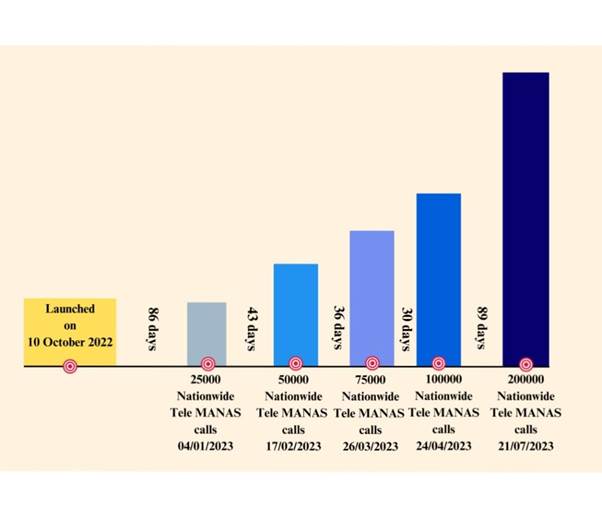Government-run Tele MANAS handles 2 lakh distress calls
Context
The main mental health issues that led Indians to contact the government-run national tele-mental health program, Tele MANAS, the digital extension of the District Mental Health Programme inaugurated in October 2022, were general feelings of depression, sleep difficulty, stress, and anxiety.
What are the psychological issues faced by Indians?
- Depression: Around the world, including India, depression is a serious mental health issue. It can be brought on by a variety of things, including stress, life changes, socioeconomic circumstances, and genetic susceptibility, and it affects people of all ages and backgrounds.
- Anxiety Disorders: Generalised anxiety disorder, social anxiety disorder, and panic disorder are the three most common anxiety disorders in India. Anxiety can have a serious negative effect on a person’s everyday functioning and general well-being.
- Bipolar disorder: This illness is marked by wildly fluctuating moods, including episodes of mania and sadness. Bipolar disorder patients may have a difficult time controlling their emotions and conduct.
- Schizophrenia: Schizophrenia is a severe and persistent mental illness that has an impact on a person’s thoughts, feelings, and actions. It may interfere with how you think, feel, and perceive the world.
- Substance abuse: Addiction to alcohol and other drugs, as well as substance abuse, can have a serious impact on a person’s general functioning and mental health.
- Post-traumatic stress disorder (PTSD): People who have been exposed to traumatic events like violent acts, natural catastrophes, or accidents may acquire PTSD, which is characterized by distressing and persistent symptoms of the trauma.
Why was District Mental Health Programme introduced and what are the objectives?
- To address mental health issues at the district level, the Indian government launched the District Mental Health Program (DMHP). It was first implemented in 1996 as a component of the National Mental Health Programme (NMHP), and its primary objective is to offer the general public easily accessible and reasonably priced mental health services.
- Early Detection and Treatment: One of the primary objectives of the DMHP is to recognize mental health problems early on and offer prompt treatment to people who are experiencing mental disorders.
- Decentralization of Mental Health Services: The program’s objective is to decentralize mental health services and make them accessible at the district level, easing the strain on specialist mental health facilities in urban regions.
- Integrating Mental Health Services with Existing General Healthcare System: The DMHP works to integrate mental health services with the current general healthcare system. By doing this, it aims to eliminate the stigma associated with mental illness and make sure that it receives the same priority as physical health.
- Human Resource Development: The program’s main goal is to train and strengthen the ability of healthcare professionals, such as doctors, nurses, and community health workers, so they may become more adept at spotting and handling mental health problems.
- Community Involvement: The DMHP is aware of the value of including regional communities in campaigns to promote and prevent mental illness. The initiative attempts to lessen the social isolation and discrimination experienced by people with mental health disorders by increasing awareness and involving community members.
- Focus on Priority Groups: The program places a strong emphasis on providing mental health care to marginalized and at-risk populations, including women, children, seniors, and those who live in rural or under resourced locations.
What does District Mental Health Programme do for the needy through Tele MANAS?
- Overview of the Program: The digital extension of India’s District Mental Health Programme, Tele MANAS is a government-run national tele-mental health program. It began operations in October 2022.
- Mental health Issues: Sadness, difficulty sleeping, worry, and anxiety are the main mental health issues that lead Indians to call the helpline. These are widespread problems that a lot of people encounter and seek assistance with.
- Milestone Attained: According to a recent update, the service has reached a critical milestone after receiving more than 2,000 calls from all over the country since it began operations.
- Operational Reach: Tele MANAS is widely dispersed across the nation, with 42 active Tele MANAS cells spread over 31 States and Union Territories.
- Call Volume: The service answers more than 1,300 calls each day, which is a significant volume. This demonstrates a strong need for assistance with mental health.
- Language Accessibility: The helpline service is more accessible to a varied community because it provides support in 20 different languages.
- Councillor Training: More than 1,900 counsellors have received training to take calls and offer first-line help to callers to give appropriate support.
Who can call Tele Manas?
- Any person who needs assistance with mental health concerns can get it from Tele MANAS programs.
- Family members of those who have mental health concerns might ask for assistance.
- Community volunteers and grass-roots healthcare workers, such as Accredited Social Health Activists (ASHAs), can contact Tele MANAS on behalf of a person or people with mental health difficulties living in that community.
By reaching out to a huge number of people and offering help for a variety of mental health challenges, Tele MANAS has established itself as a crucial platform for enhancing the delivery of mental health services in India. Its popularity and effectiveness are boosted by the availability of support in a variety of languages and the choice to chat with certified counsellors.





